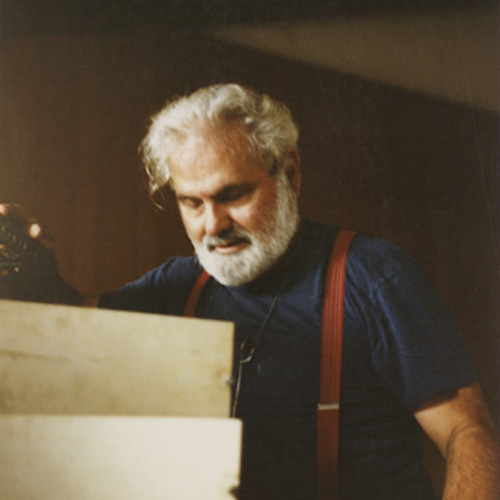
Salvatore
Martirano
Martirano
by Dorothy Martirano

"Salmar Construction" by Salvatore Martirano
The SalMar Construction is an amazing large music synthesis engine conceived and constructed in the early 1970s by a composer for use by a composer.
Under development from the late 1960s, the SalMar is believed to be the first interactive "composing machine," with digital logic circuits at its heart. When you listen to this recorded performance of Sal Martirano playing his "Construction," you experience such mastery. The instrument under his command does his bidding, and what you hear are compositions, not jams.
The Sal Mar Project in University of Illinois, Center for American Music
The Sal-Mar Construction is in the Center for American Music and the Sousa Archives on the 2nd floor of the Harding Band Building. Directions: Enter through 6th street entrance, take stairs up to 2nd floor, turn left, enter door on left for Sousa archives. The Sal Mar construction is located in the far NE corner of the gallery space.
Sal-Mar Live Performance
April of 2004 at "New Directions in the Study of Musical Improvisation: An Interdisciplinary and Intercultural Conference" hosted by the UIUC Musicology division. It features David Rosenboom, dean CAL Arts, playing the SAL MAR for the first time in 20 years ; the culmination of the efforts to revive this amazing instrument!
In 1969, Salvatore Martirano along with a group of engineers and musicians at the University of Illinois began work on the design and construction of a musical electronic instrument. The instrument, named the SAL-MAR CONSTRUCTION, is a hybrid system in which TTL logical curcuits (small and medium scale integration) drive analog modules, such as voltage-controlled oscillators, amplifiers and filters.
The performer sits at a horizontal control panel of 291 lightable touch-sensitive switches (no moving parts). The two-state switches are used by a performer to dial sequences of numbers that are characterized by a variety of intervals and lengths. A sequence may then bypass, address, or be added to other sequences forming an interlocked tree of control and data according to a performer's choice. The unique characteristic of the switch is that it can be driven both manually and logically, which allows human/machine interaction. The most innovative feature of the human/machine interface is that it allows the user to switch from control of macro to micro parameters of the information output. This is analogous to a zoom lens on a camera.
The information output is converted from digital to analog form and is routed to oscillators, filters and amplifiers, whose output is sent to one or more of 24 speakers. Four groups of sounds with independant control of route and rate can be distributed among the 24 speakers so that a traffic of sound is created in the space. All sounds are produced in real-time as the composer/performer according to his own prerogatives chooses a route and functions through a store of pre-programmed information.
The instrument measures 8' x 4.5' x 2.5' and weighs about 400lbs. The speakers each weighing about 10 lbs are hung from the ceiling in one of a number of arrays at diverse heights in and above the audience. The SAL-MAR could take half a day to set up but can be torn down in about 2 hours.
The Sal-Mar Construction has been set up and performed in many different environments for audiences of all sizes. For example, performances were given at the West Hubbard Art Gallery in Chicago, a 40' x 60' open space with an audience of 100, at Cooper Union in New York City, a 900 seat concert hall and at the Miller Outdoor Theatre in Houston, Texas, 5000 in the shed and on the surrounding hill.
"...Basically (The SAL-MAR) is an attempt - and in the opinion of most observers a highly successful one - to solve a problem which has intrigued musicians for several years: the real-time generation of electronic music. The conventional electronic synthisizer is severely limited as a real-time instrument since it can produce only a limited number of sound events without manual change of its circuitry. Mr. Martirano's solution has been to incorporate a digital computer within the framework of a large, multichannel synthisizer. Seated at a console of 291 switches, the composer-performer controls the course of the performance by selecting material from an infinity of possibilities, choosing the permutations through which it passes and directing its movement in space..."
--From a statement by ???

"The most often asked question after a concert performance with Sal-Mar was: "Do you know what it will do next?". Though too complex to analyze it was possible to predict what sound would result and this caused me to lightly touch or slam the switch as if this had an effect on the two-state logic. I was in the loop, trading swaps with the logic. Let's face it, there are some things you can't talk about and make much sense. I enabled paths, or better, I steered. To make music with the SMC is like driving a flying bus."
Salvatore Martirano
Circuits for the SAL-MAR Construction were designed and built by:
- Salvatore Martirano
Professor Emeritus, University of Illinois - Sergio Franco
Formerly research engineer, Illiac III Project - James Divilbiss
Chief engineer on the Iliac project, worlds 1st supercomputer
Professor of Library Science, University of Illinois
Specialist in automated library systems - Richard Borovec
Formerly chief engineer, Illiac III Project
- Jay Barr
Maintenance technition and programmer for Bell Telephone, Champaign, Illinois - Josef Sekon
- Terry Mohn